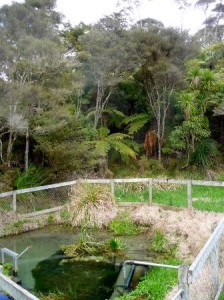
In the past week water usage in Raglan peaked at 2136 cubic metres on Sunday 24th February. This is well down on this year’s peak usage of 2410 cubic metres on 27th January. The current maximum use of 2136 cubic metres a day is well within the capacity of the Raglan water supply.
In the type of quirky move that the Waikato District Council is well known for, WDC responded to the reduced water use in Raglan by declaring a sprinkler ban. Yes folks we are now at Level 3 restrictions on the “Smart Water” scale. Raglan 23 has been told that this is because Raglan is a part of WDC’s ‘district-wide’ approach. This means that there is a total ban on domestic sprinklers and irrigation systems and restrictions on outdoor water use for commercial properties.
The water usage in Raglan for the past week was:
| Mon
18 Feb |
Tues
19 Feb |
Wed
20 Feb |
Thurs
21 Feb |
Fri
22 Feb |
Sat
23 Feb |
Sun
24 Feb |
|
| Raglan |
1980 | 2034 | 1991 | 2007 | 2106 | 2032 | 2136 |
Water usage in cubic metres
>>>>>>>>>>>>>>>>>>>>>>>>>>>>>>>>>>>>>>>>>>>>>>>>
Media Release: Waikato District Council, 27.02.2013
Water restrictions increase – Sprinkler ban for Waikato District
A total ban on domestic sprinklers and irrigation systems and restrictions on outdoor water use for commercial properties will be introduced to Hamilton and Waikato District from today.
The increase in water restrictions to Water Alert Level 3, which does permit hand held watering at any time, follows rising water consumption figures and forecasts of ongoing hot dry weather for the city and district. Waipa District Council is already on Water Alert Level 3 restrictions. The summer of 2007/08 was the last time Hamilton had a total sprinkler ban.
Hamilton City Council City Waters Manager Tim Harty said the city’s water use had been climbing steadily over the past week, with 77 million litres used yesterday compared to a average usage this time of year of around 60 million litres.
“Our long hot summer continues and with it has come increasing demand for water. Thanks to those who have abided by the water restrictions to date, but we now need to ensure water is used in a sustainable manner.”
Waikato District Council Water and Facilities General Manager Richard Bax said many areas of both Council’s business have already reduced water use.
“Between both Councils we have stopped fleet washing, building washing, pipe flushing, and turned off fountains. We have reduced the watering of flower beds and parks, and reduced the use of water by roading contractors.“
A range of methods are being used around the city and district to ensure residents are aware of the new restrictions, including posters, signs on arterial routes, electronic message boards, social media and newspaper and radio advertising. Direct contact is ongoing with major commercial and non-residential water users around essential and non-essential outdoor water use.
In Hamilton water monitors will also be out and about in the city educating and ensuring adherence to restrictions. To date Hamilton has received 94 complaints around improper water use. Those with concerns about improper water use can report this by:
• Phoning the Hamilton City Infrastructure Customer Service team on 838 6999
• Emailing Hamilton’s cityinfrastructure@hcc.govt.nz
• Filling in an online form on Hamilton’s website
• Phoning Waikato District Council on 0800 492 452
The decision to move between alert levels is made based on a number of factors including consumption, weather forecasts, drought conditions, river levels and annual trend data.
Monitoring of daily water use and Waikato River and Lake Taupo levels is ongoing as part of reviewing water restriction levels.
More information on water consumption and alert levels is available on www.hamilton.co.nz/smartwater and www.waikatodistrict.govt.nz and www.waikatoregion.govt.nz/Community/Whats-happening/Smart-water-use .


If water use is declining in Whaingaroa, then installing water meters can only be a revenue gathering exercise for WDC rather than a water conservation exercise.
The biggest problem with water meters in Raglan is that they would stop people paying their fair share of the costs. The cost of the water pumps and pipes is driven by the peak usage requirement on the few days in early January when lots of visitors are in Raglan and saying overnight. Water meters would see charges drop for bach owners who are only here a small numbers of days a year and increase for permanent residents. Also because of WDC’s ‘district wide approach’, the good folk in Ngaruawahia and Huntly would also be subsidising the Raglan bach owners.
Water meters make no sense in Raglan at all.
Yet the Community Board seems to have accepted the 12 Feb report saying further work on manifold upgrades and meter installation will be done by Allens from March to May. $400,000 was budgeted for the work, which is more than it cost to build the Habitat affordable home.
Good point John. Why don’t you raise it with a RCB member.
I guess the same argument could be used for removing power and gas meters.
A targeted rate has cross subsidy. Metering at the very least, identifies leakage and waste. We know from past experience that there are significant numbers of these in the district including Raglan. We also know that it is very challenging to get owners to fix leaks or stop waste.
I would expect that Raglan, with it’s strong environmental awareness, would be leading the way in wanting to reduce waste.
Raglan is environmentally aware and WDC water use stats show that Raglandic people are already using water wisely.